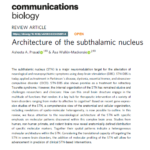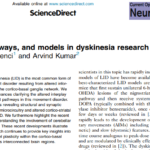Only logged-in members can add their publications.
- New Publication: Architecture of the subthalamic nucleus

Authors:
Asheeta A. Prasad & Åsa Wallén-MackenzieAbstract:
The subthalamic nucleus (STN) is a major neuromodulation target for the alleviation of neurological and neuropsychiatric symptoms using deep brain stimulation (DBS). STN-DBS is today applied as treatment in Parkinson´s disease, dystonia, essential tremor, and obsessive-compulsive disorder (OCD). STN-DBS also shows promise as a treatment for refractory Tourette syndrome. However, the internal organization of the STN has remained elusive and challenges researchers and clinicians: How can this small brain structure engage in the multitude of functions that renders it a key hub for therapeutic intervention of a variety of brain disorders ranging from motor to affective to cognitive? Based on recent gene expression studies of the STN, a comprehensive view of the anatomical and cellular organization, including revelations of spatio-molecular heterogeneity, is now possible to outline. In this review, we focus attention to the neurobiological architecture of the STN with specific emphasis on molecular patterns discovered within this complex brain area. Studies from human, non-human primate, and rodent brains now reveal anatomically defined distribution of specific molecular markers. Together their spatial patterns indicate a heterogeneous molecular architecture within the STN. Considering the translational capacity of targeting the STN in severe brain disorders, the addition of molecular profiling of the STN will allow for advancement in precision of clinical STN-based interventions. - New Publication: Cells, pathways, and models in dyskinesia research

Authors:
M. Angela Cenci, Arvind KumarAbstract:
L-DOPA-induced dyskinesia (LID) is the most common form of hyperkinetic movement disorder resulting from altered information processing in the cortico-basal ganglia network. We here review recent advances clarifying the altered interplay between striatal output pathways in this movement disorder. We also review studies revealing structural and synaptic changes to the striatal microcircuitry and altered cortico-striatal activity dynamics in LID. We furthermore highlight the recent progress made in understanding the involvement of cerebellar and brain stem nuclei. These recent developments illustrate that dyskinesia research continues to provide key insights into cellular and circuit-level plasticity within the cortico-basal ganglia network and its interconnected brain regions.https://www.sciencedirect.com/science/article/pii/S0959438823001587
